A Complete Guide on the Types of Washing Machines
A washing machine is an inevitable appliance to do your day-to-day laundry. Choosing the right type of washing machine can save your water, electricity, and your overall utility bills.
Getting the right type of washing machine can be tricky. Because there are a lot of options and brands in the market. You must know the different options available to pick the right type of machine for your laundry requirements.
First, let us understand the basic types of washing machines and dive deep into each one of their features and working.
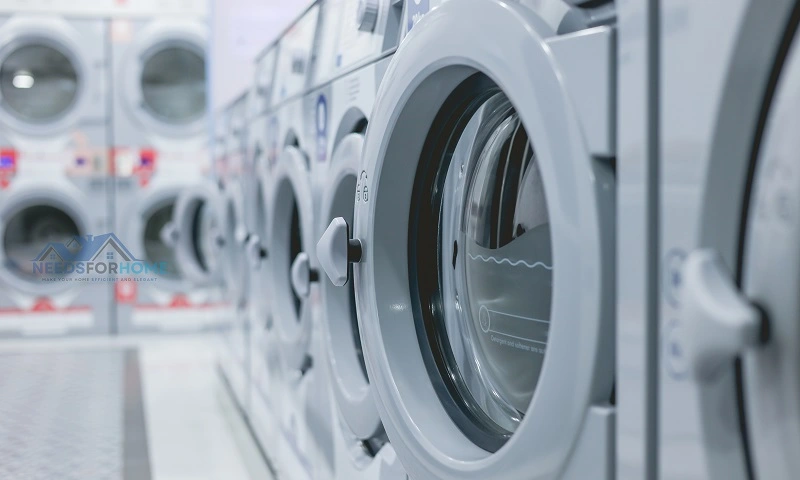
Basic Types of Washing Machines
Washing machines can be classified into the following major categories:
- Top-Loading Washing Machines – This is the traditional type of washer in which the laundry is fed from the top and has a vertical wash tub. Top-load washers are considered low in efficiency. But there are highly efficient washer types too.
- Front-Loading Washing Machines – Front-load washers have a door in the front and a horizontal drum. The laundry is fed through the front door. Front-load washers are highly efficient in washing and gentle on your clothes.
- Fully Automatic Washing Machines – The entire wash cycle and spin cycle are fully automatic. This means, you just have to load the laundry and let the machine do all the work without human intervention.
- Semi-Automatic Washing Machines – These machines require human intervention to shift the clothes from the wash cycle to the spin cycle. But you can have a more personalized washing experience with mechanical controls.
- Specialized Washing Machines – These washers satisfy a specific purpose and use case. You have portable washing machines, compact washing machines, smart washing machines, and a stacked washer-dryer combo under this category.
Top-Load Washing Machines
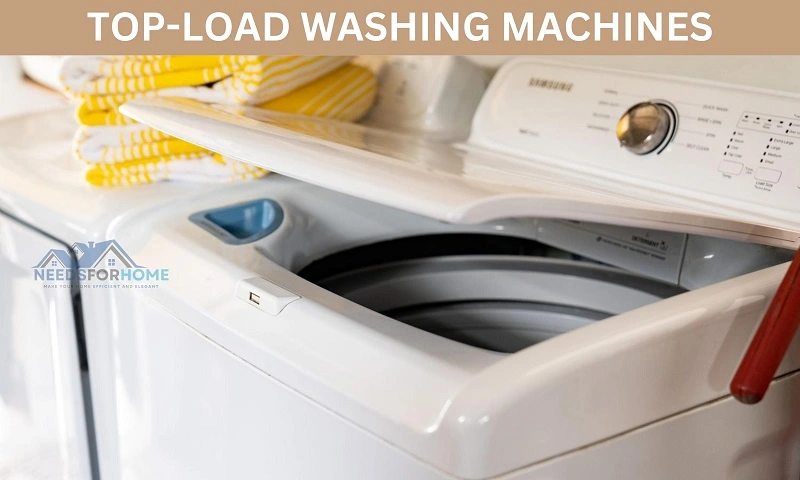
As the name suggests, the laundry is loaded from the top in the top-load washers. They have a vertical drum known as the washer tub where all the washing and spin cycle takes place.
Top-load washers are characterized by their agitator or impeller design inside the washer tub. Based on this top-load washers can be classified further into two types:
- Traditional Agitator Models
- High-Efficiency Impeller Models
Traditional Agitator Models
The traditional agitator models have a spindle in the center with fins. This spindle is known as the agitator. The agitator helps in tumbling the laundry during the wash cycle and spin cycle.
However, the agitator occupies a significant space in the washer tub. This reduces the loading capacity of the washer. Also, the machine requires more water to agitate the clothes which makes the top-load washers less efficient.
High-Efficiency Impeller Models
On the other hand, we have the high-efficiency impeller models. Instead of an agitator, these models have low-profile fins at the bottom of the washer tub. These fins are known as impeller and it aids in agitating the clothes.
High efficiency can be achieved with the impeller models since the washing machine doesn’t consume more power and water to agitate the clothes.
You can learn more about the different parts of washing machines to understand how each of them works.
In general, Top-load washing machines are better for large laundry like blankets, carpets, rugs, etc. They can be easily tumbled around and washed thoroughly. But if you are looking for higher efficiency, you have to choose the impeller model or front-load washers.
Pros of Top-Load Washing Machines:
- Cost-Effective: One of the key advantages of top-loader washers is their affordability. They are often priced lower than their front-load counterparts, making them a popular choice for budget-conscious consumers.
- Quick Access: With top-loader washers, you can add clothes even after the wash cycle has started. This feature can be particularly handy if you’ve forgotten to include an item in your initial load.
- Familiar Design: Many users are accustomed to the traditional top-load design, which can make transitioning to a new washing machine easier.
- Strong Washing: Top load washers can be used for heavy laundry. They can wash, spin, and rinse huge laundry with ease.
- Easy Maintenance: You can easily maintain top load washers since the tub is easily accessible.
Cons of Top-Load Washing Machines:
- Less Energy-Efficient: While top-loaders have their merits, they tend to use more water and energy compared to front-load machines. This can result in higher utility bills over time.
- Smaller Capacity: Some top-load models may have a smaller load capacity due to the agitator in the center of the drum, which takes up space that could be used for clothes.
- High Water Consumption: Top-load washers consume more water to agitate and wash the clothes.
- Vibration and Noise: You may experience higher vibration and noise in top load washers due to the presence of an agitator. The tumbling of laundry creates more vibration and noise, especially during the spin cycle.
Front-Load Washing Machines
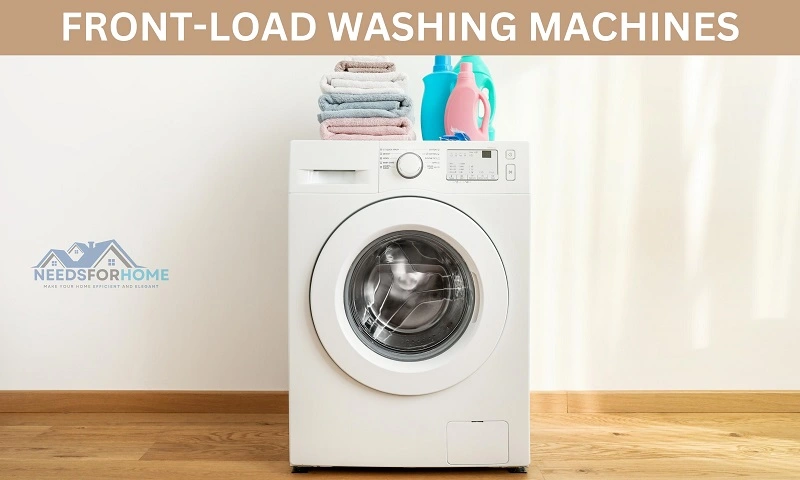
Front-load washing machines feature a horizontal drum and a door on the front, allowing you to load your laundry horizontally. Front load washers are efficient and offer gentle cleaning.
Water consumption in front-load washing machines is very low. Also, due to the gravity-assisted horizontal tumbling of laundry, the noise and vibration are significantly less.
Front-load washers are fully automatic machines. Therefore, they offer a variety of wash cycles combined with higher efficiency. They consume very little power and water to wash the laundry.
The detergent used for front-load washers is also quite different from top-load washers.
You can learn more about the working of front load and top load washers to understand the differences between them.
Pros of Front-Load Washing Machines:
- Energy Efficiency: Front-load washers are designed to be highly energy-efficient. They use less water and less energy, which can lead to significant savings on your utility bills.
- Better Cleaning: The tumbling action of front-load machines is gentler on clothes and more effective at removing tough stains. This means your clothes come out cleaner with less wear and tear.
- Higher Capacity: Front-load machines typically have a larger load capacity, making them suitable for larger households with more laundry to tackle.
- Less Noise and Vibration: Due to gravity-assisted tumbling of laundry, the noise and vibration are very low.
- Fully Automatic: Front-load washers are fully automatic machines. Therefore, you don’t have to stay with the machine while washing.
Cons of Front-Load Washing Machines:
- Higher Initial Cost: While front-loaders offer long-term savings, they often come with a higher initial purchase price. However, the energy savings can help offset this cost over time.
- Longer Wash Cycles: Some front-load washing machines have longer wash cycle durations compared to top-loaders. This may require some adjustment to your laundry routine.
- Frequent Maintenance: Front load washers need regular maintenance. Detergent might sediment on the door and tub which must be regularly cleaned.
Fully Automatic Washing Machines
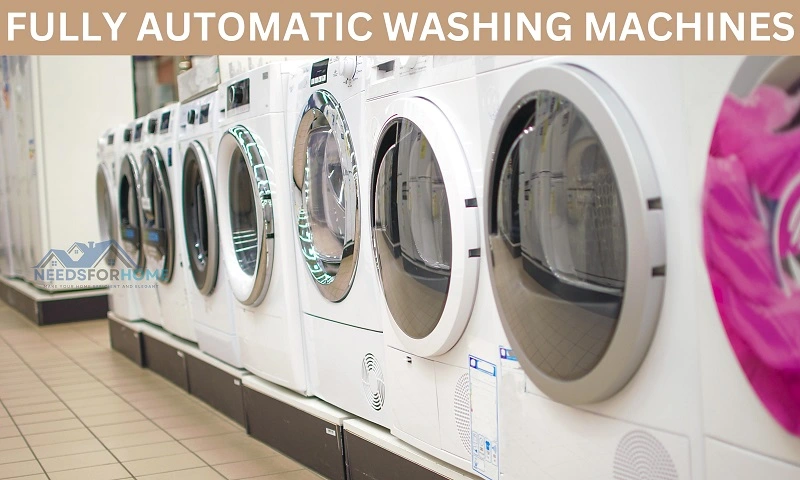
Automatic washing machines, as the name suggests, automate the entire laundry process. These machines handle everything from washing to spinning without requiring manual intervention. They are available in various capacities, offering a range of cycle options to suit your specific needs.
Fully automatic machines are available in both front-load and top-load washer variants. It is highly sophisticated and easy to use without any need for manual intervention at any point in the wash cycle.
Since the washing cycle is fully automatic, you can have less water and energy usage with every wash. Also, you get to use the different varieties of washing programs to get the best washing for each type of laundry.
Pros of Fully Automatic Washing Machines:
- Convenience: Automatic washing machines provide unmatched convenience. They handle the entire laundry process without requiring manual intervention, making them a time-saving solution for busy households.
- Time-saving: Automatic machines complete the entire washing process faster compared to semi-automatic machines, making them ideal for those who need quick and efficient laundry solutions.
- Advanced Features: Many automatic models come equipped with advanced features such as load sensors, precise temperature control, and a wide range of wash cycles. This ensures thorough cleaning and care for various fabric types.
Cons of Fully Automatic Washing Machines:
- Cost: Automatic washing machines are often more expensive than their semi-automatic counterparts. The initial investment can be a significant consideration for budget-conscious consumers.
- Water and Energy Consumption: While they offer convenience, automatic machines tend to use more water and energy. This can result in higher operating costs over time, particularly if you live in an area with high utility rates.
Semi-Automatic Washing Machines
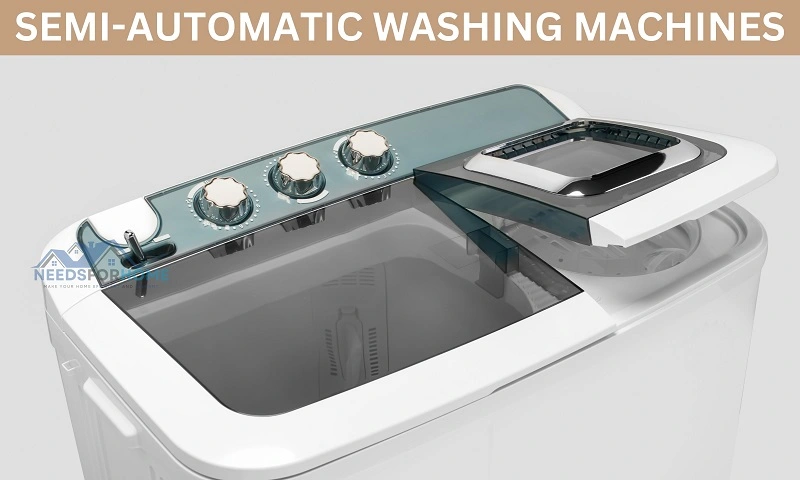
Semi-automatic washing machines are a budget-friendly alternative to fully automatic models. These machines require some manual intervention, such as moving clothes between the wash and rinse tubs.
The semi-automatic variant is only available in top-load washers. You will have a twin-tub configuration where one tub is used for washing and rinsing while the other tub is used for spinning the clothes dry.
The semi-automatic washers don’t offer many wash cycles and they are more focused on strength of washing and timing of the wash cycle. This means that you can set how long the wash cycle to last and how strong should the agitation be. The same goes for the spin cycle too.
Therefore, you may not have much sophistication, and if you don’t know how to set the wash cycle appropriately, you may waste a lot of power. It requires some kind of optimized setting which a user must find out on their own.
Although modern semi-automatic washers are more user-friendly, they still lack the high efficiency produced by fully automatic front-load washers.
You can find more operational differences between fully automatic and semi-automatic washers to get better insights.
While they may involve more hands-on work, they come with their own set of advantages.
Pros of Semi-Automatic Washing Machines:
- Cost-Effective: Semi-automatic machines are typically more affordable upfront, making them an excellent choice for those on a tight budget or looking for a budget-friendly laundry solution.
- Control: With a semi-automatic machine, you have more control over the wash process. You can customize the wash duration and rinse as needed, allowing you to tailor each cycle to your specific requirements.
- Water Savings: Semi-automatic machines use less water compared to automatic machines, which can lead to savings on your water bill. This makes them an eco-friendly option.
Cons of Semi-Automatic Washing Machines:
- Manual Effort: Using a semi-automatic machine requires manual effort, such as moving clothes between tubs and monitoring the wash process. This can be less convenient compared to fully automatic models, especially for those with busy schedules.
- Time-Consuming: Semi-automatic machines can be more time-consuming as they require your active involvement throughout the wash cycle. If you have limited time for laundry, this may be a drawback.
- Limited Features: These machines may have fewer features and wash cycle options compared to automatic machines. If you value a wide variety of wash programs and advanced settings, this could be a limitation.
Specialized Washing Machines
There are some special scenarios in which you cannot use the typical washer types we discussed above. You will need a special configuration to satisfy that particular requirement. So, keeping that in mind, specialized washing machines can be found with the following configurations:
- Smart Washing Machines
- Large Capacity Washing Machines
- Portable and Compact Washing Machines
- Stacked Washer Dryer Combo
Smart Washing Machines
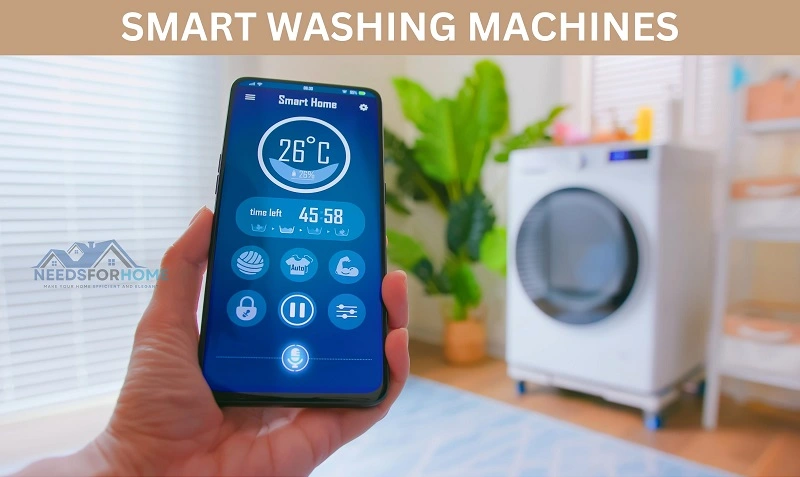
In the age of smart technology, washing machines have also undergone a transformation. Smart washing machines are equipped with IoT (Internet of Things) connectivity, allowing you to control and monitor your washer remotely via a mobile app.
These are fully automatic washers equipped with network connectivity and smartphone integration. Once you pair the smart washer with your home’s network, you can do your laundry with your mobile app. It is very convenient for users with a busy schedule and no time to sit for laundry.
Smart washing machines enable you to modify a wash cycle, start/stop the cycle, turn on and off the washer, and much more.
These smart washers also provide you with diagnostics and constantly update you on potential issues or maintenance requirements.
Large-Capacity Washing Machines
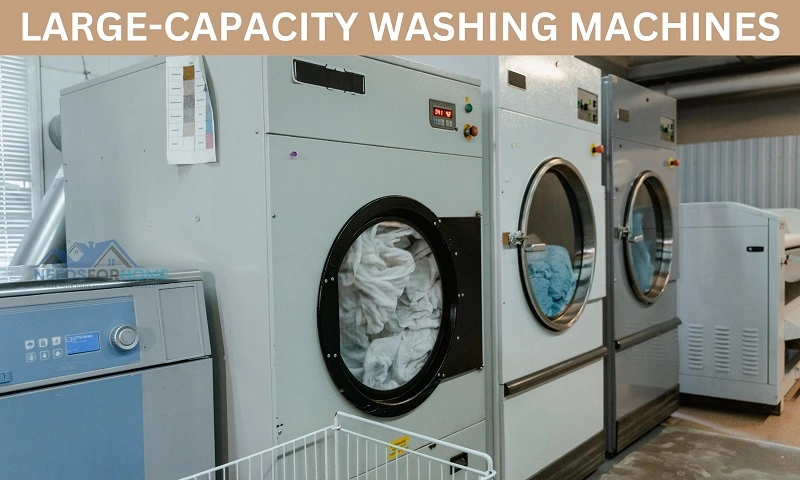
For larger families or individuals with substantial laundry requirements, large-capacity washing machines are a valuable asset. These machines offer extra load space, making it possible to tackle even the bulkiest laundry with ease.
These are commonly used in commercial laundry services, industrial spaces, and people with large families.
They are usually front-load machines with higher capacity than the typical washers. Front-load washers enable better efficiency and provide variable wash cycles.
Portable and Compact Washing Machines
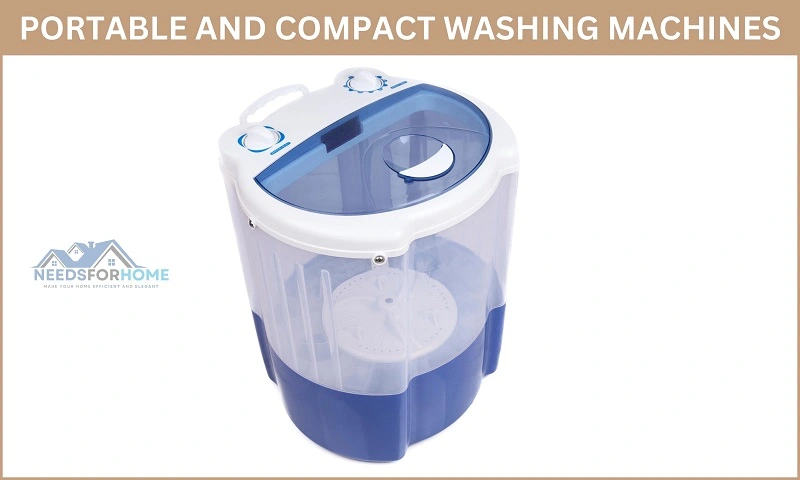
Portable and Compact washing machines are designed with space-saving in mind. These machines cater to smaller living spaces, such as apartments, tiny homes, or RVs, where a full-sized washing machine might not be practical.
Perhaps the most significant advantage of compact washing machines is their small footprint. They can fit into tight spaces or even be tucked away in a closet when not in use.
Some compact models are lightweight and equipped with wheels, making them easy to move around. This flexibility can be especially useful if you’re on the go or need to store the machine after use.
Due to their compact size, these machines typically have a smaller load capacity. This means you’ll need to do more frequent loads for larger amounts of laundry.
Compact models may offer fewer wash cycle options and features compared to standard-sized machines. However, they still provide the essential functions for clean clothes.
Stacked Washer Dryer Combo
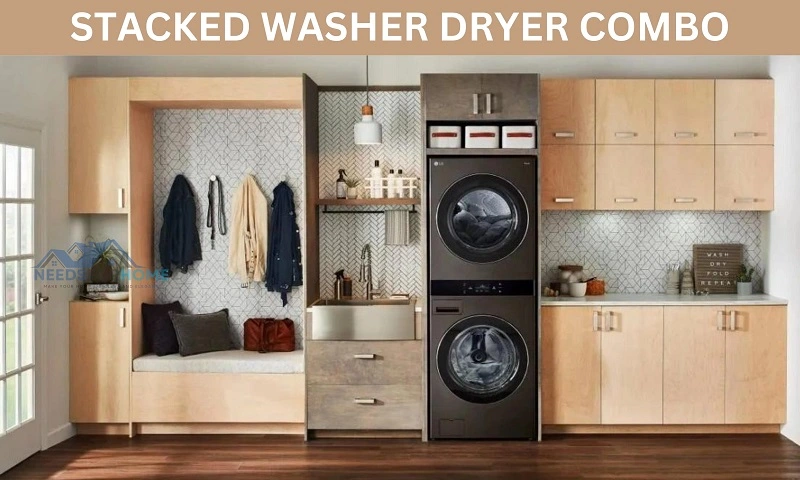
These are also commonly used in commercial laundry services and in geographic regions where outdoor drying of laundry is impossible.
You will have both the washer and dryer stacked one above the other. The washer usually sits below and the dryer is placed on top of it.
It is convenient to wash the clothes and dry them inside the home without any need for passive outdoor drying.
In extremely cold weather or rainy seasons, this stacked washer-dryer combo helps you to do your laundry conveniently.


